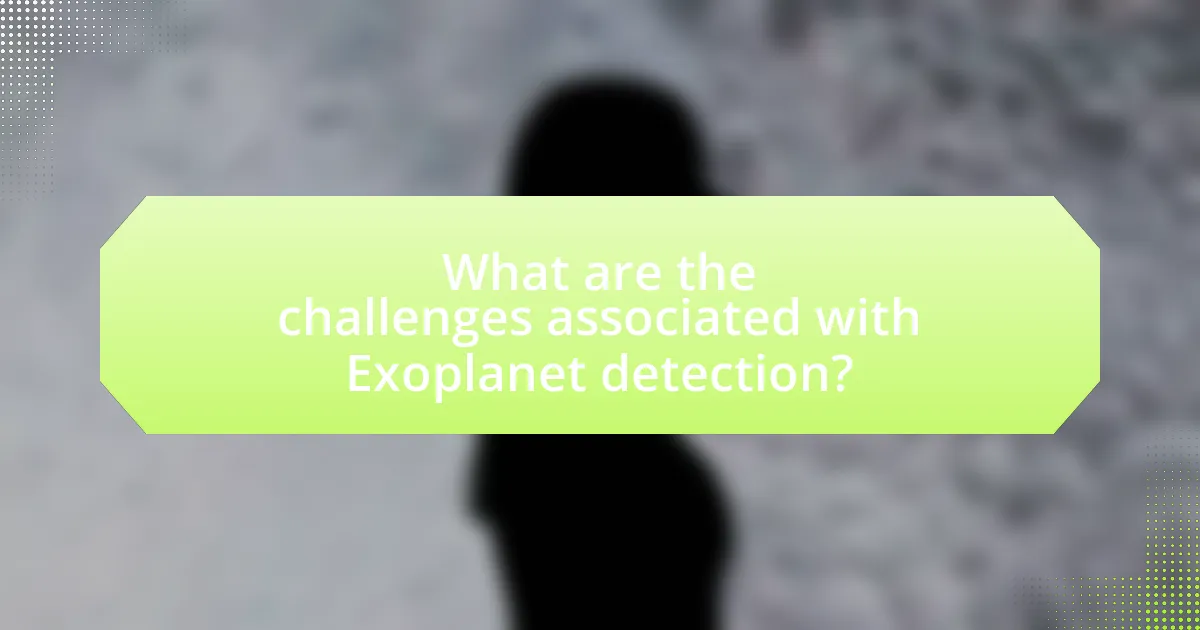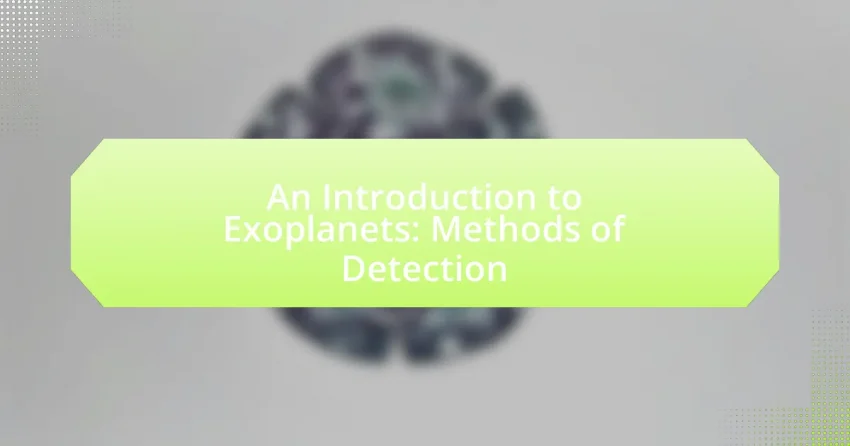Exoplanets are planets located outside our solar system, orbiting stars other than the Sun. This article provides a comprehensive overview of exoplanets, including their definitions, characteristics, and the various methods used for their detection, such as the transit method and radial velocity method. It also explores the significance of studying exoplanets for understanding planetary systems and the potential for extraterrestrial life, as well as the challenges and advancements in detection technologies. Key classifications of exoplanets, including terrestrial and gas giants, are discussed, along with the implications of these discoveries for future astronomical research.

What are Exoplanets?
Exoplanets are planets that exist outside our solar system, orbiting stars other than the Sun. These celestial bodies have been confirmed through various detection methods, including the transit method, where a planet passes in front of its host star, causing a measurable dimming of the star’s light. As of October 2023, thousands of exoplanets have been discovered, expanding our understanding of planetary systems and the potential for life beyond Earth.
How are Exoplanets defined in astronomy?
Exoplanets are defined in astronomy as planets that orbit stars outside our solar system. This definition encompasses a wide variety of celestial bodies, including those that may be similar to Earth or vastly different. The first confirmed detection of an exoplanet occurred in 1992, when astronomers discovered planets orbiting a pulsar, marking a significant milestone in the field. Since then, thousands of exoplanets have been identified using various detection methods, such as the transit method and radial velocity technique, which provide evidence of their existence and characteristics.
What characteristics distinguish Exoplanets from other celestial bodies?
Exoplanets are distinguished from other celestial bodies primarily by their location and the fact that they orbit stars outside our solar system. Unlike planets within our solar system, exoplanets are found in various star systems, and their detection often relies on methods such as the transit method, where a planet passes in front of its host star, causing a measurable dimming of the star’s light. Additionally, exoplanets can exhibit a wide range of characteristics, including diverse atmospheres, compositions, and potential habitability, which are studied through spectroscopy and other observational techniques. These unique features set exoplanets apart from other celestial bodies like asteroids or moons, which typically do not orbit stars and have different formation processes.
Why is the study of Exoplanets important for understanding the universe?
The study of exoplanets is crucial for understanding the universe because it helps scientists identify the potential for life beyond Earth and reveals the diversity of planetary systems. By examining exoplanets, researchers can gather data on their atmospheres, compositions, and orbits, which enhances our knowledge of how planets form and evolve. For instance, the discovery of the first exoplanet orbiting a sun-like star in 1995 marked a significant milestone, demonstrating that planets exist outside our solar system. Furthermore, missions like Kepler and TESS have cataloged thousands of exoplanets, providing insights into the frequency of Earth-like planets in habitable zones, which is essential for assessing the likelihood of extraterrestrial life.
What types of Exoplanets exist?
There are several types of exoplanets, including terrestrial planets, gas giants, ice giants, and super-Earths. Terrestrial planets, like Earth and Mars, are rocky and have solid surfaces. Gas giants, such as Jupiter and Saturn, are primarily composed of hydrogen and helium and lack a well-defined solid surface. Ice giants, including Uranus and Neptune, have a composition that includes water, ammonia, and methane ices. Super-Earths are larger than Earth but smaller than gas giants, often with rocky compositions and potential atmospheres. These classifications are based on their physical characteristics and compositions, as identified through various detection methods such as transit photometry and radial velocity measurements.
How do scientists categorize Exoplanets?
Scientists categorize exoplanets based on their physical characteristics and orbital properties. The primary categories include terrestrial planets, gas giants, ice giants, and super-Earths, which are differentiated by their composition, size, and density. For instance, terrestrial planets are rocky and similar to Earth, while gas giants are predominantly composed of hydrogen and helium. Additionally, exoplanets are classified by their orbital distance from their host stars, leading to classifications such as hot Jupiters, which orbit very close to their stars, and cold gas giants, which are located further away. This categorization is supported by data from missions like Kepler and TESS, which have provided extensive information on the size, mass, and temperature of these planets, allowing for a systematic classification based on established criteria.
What are the differences between gas giants and terrestrial Exoplanets?
Gas giants and terrestrial exoplanets differ primarily in their composition and physical characteristics. Gas giants, such as Jupiter and Saturn, are predominantly composed of hydrogen and helium, lacking a solid surface, while terrestrial exoplanets, like Earth and Mars, are rocky and have solid surfaces. Gas giants typically have thick atmospheres and can possess extensive ring systems and numerous moons, whereas terrestrial planets have thinner atmospheres and fewer moons. The distinction is further supported by the classification of exoplanets based on their mass and density, with gas giants generally having lower densities compared to the denser, solid terrestrial planets.

What are the primary methods of detecting Exoplanets?
The primary methods of detecting exoplanets are the transit method, radial velocity method, direct imaging, and gravitational microlensing. The transit method involves observing the dimming of a star’s light as a planet passes in front of it, which has been successfully used by missions like Kepler, detecting thousands of exoplanets. The radial velocity method measures the star’s wobble due to gravitational pull from an orbiting planet, providing data on the planet’s mass and orbit; this technique has confirmed many exoplanets since the first detection in 1995. Direct imaging captures images of exoplanets by blocking out the star’s light, allowing for the study of their atmospheres and compositions. Gravitational microlensing occurs when a massive object, like a star, magnifies the light of a more distant star, revealing the presence of planets around the foreground star. Each of these methods has contributed significantly to the growing catalog of known exoplanets.
How does the Transit Method work in detecting Exoplanets?
The Transit Method detects exoplanets by observing the periodic dimming of a star’s light caused by a planet passing in front of it. When a planet transits, it blocks a fraction of the star’s light, leading to a measurable decrease in brightness. This method relies on precise photometric measurements to identify the characteristic light curve, which shows the star’s brightness over time. The depth and duration of the dip in brightness provide information about the planet’s size and orbital period. The Kepler Space Telescope, for example, utilized this method to discover thousands of exoplanets by monitoring the brightness of over 150,000 stars continuously for several years, confirming the effectiveness of the Transit Method in exoplanet detection.
What are the key steps involved in the Transit Method?
The key steps involved in the Transit Method include monitoring a star’s brightness over time, detecting periodic dips in brightness, confirming the dips are due to a planet transiting in front of the star, and analyzing the depth and duration of the transit to determine the planet’s size and orbital period. This method relies on the principle that a planet passing in front of its host star will block a fraction of the star’s light, leading to measurable changes in brightness. The Kepler Space Telescope, for example, utilized this method to discover thousands of exoplanets by observing the light curves of stars and identifying these characteristic transits.
What limitations does the Transit Method have?
The Transit Method has several limitations, primarily its inability to detect exoplanets that do not pass directly in front of their host stars from our viewpoint. This method relies on observing a temporary dimming of a star’s light caused by a planet transiting, which means that only a small fraction of planets can be detected, particularly those with orbits aligned with Earth. Additionally, the Transit Method is less effective for detecting smaller planets, as the dimming effect is more pronounced for larger planets. Furthermore, it cannot provide information about the planet’s atmosphere or surface conditions without additional observational techniques. These limitations highlight the need for complementary methods, such as radial velocity measurements, to gain a more comprehensive understanding of exoplanets.
What is the Radial Velocity Method and how does it function?
The Radial Velocity Method is an astronomical technique used to detect exoplanets by measuring the changes in the velocity of a star due to the gravitational influence of an orbiting planet. This method functions by observing the Doppler effect, where the light from a star shifts in wavelength as it moves towards or away from Earth. When a planet orbits a star, it causes the star to wobble slightly, resulting in periodic shifts in the star’s spectral lines. These shifts can be quantified to determine the presence of a planet, its mass, and its orbital characteristics. The method has successfully identified thousands of exoplanets, providing critical data for understanding planetary systems.
What measurements are taken in the Radial Velocity Method?
The Radial Velocity Method measures the Doppler shifts in the spectrum of a star caused by the gravitational influence of an orbiting planet. This method detects changes in the star’s velocity along the line of sight, which results in periodic shifts in the wavelengths of spectral lines. Specifically, the measurements focus on the star’s radial velocity, which is calculated by observing the changes in the wavelengths of light emitted by the star, typically in the visible spectrum. The accuracy of these measurements can be as precise as a few meters per second, allowing astronomers to infer the presence of exoplanets based on the observed periodic variations in the star’s motion.
How does this method contribute to our understanding of Exoplanets?
This method enhances our understanding of exoplanets by providing precise measurements of their atmospheric composition and physical characteristics. For instance, the transit method allows astronomers to detect the slight dimming of a star’s light as a planet passes in front of it, enabling the analysis of the planet’s atmosphere through spectroscopy. This technique has revealed the presence of water vapor, carbon dioxide, and other molecules in the atmospheres of various exoplanets, contributing to our knowledge of their potential habitability and climatic conditions.

What are the challenges associated with Exoplanet detection?
The challenges associated with exoplanet detection include the limitations of current observational technologies, the faintness of exoplanets compared to their host stars, and the interference from stellar activity. Current telescopes struggle to distinguish the light of distant exoplanets from the overwhelming brightness of their stars, making direct imaging difficult. For instance, the transit method, which relies on detecting dips in starlight as a planet passes in front of its star, can be complicated by false positives from other celestial phenomena. Additionally, stellar activity, such as flares and spots, can mimic the signals of exoplanets, leading to misinterpretations. These factors collectively hinder the accurate identification and characterization of exoplanets.
Why is detecting Exoplanets difficult?
Detecting exoplanets is difficult primarily due to their vast distances from Earth and the faintness of the signals they emit. Exoplanets are often overshadowed by the brightness of their host stars, making it challenging to observe them directly. For instance, the transit method, which relies on detecting the slight dimming of a star as a planet passes in front of it, requires precise measurements of light intensity, which can be complicated by stellar variability. Additionally, the radial velocity method, which measures the star’s wobble due to gravitational pull from an orbiting planet, is sensitive to noise and requires high-precision instruments. These factors contribute to the complexity and difficulty of confirming the existence of exoplanets.
What role does distance play in the detection of Exoplanets?
Distance significantly affects the detection of exoplanets by influencing the brightness of the host star and the ability to observe transits or other signals. Closer exoplanets are easier to detect because their gravitational influence on their stars can be observed more readily, and their transits cause more noticeable dips in brightness. For instance, the Kepler Space Telescope primarily focused on stars within 3,000 light-years, where it could effectively monitor light variations. Additionally, the radial velocity method, which measures the star’s wobble due to an orbiting planet, is more sensitive to nearby stars, as the gravitational effects are more pronounced. Thus, the proximity of exoplanets to Earth enhances the likelihood of detection through various observational techniques.
How do atmospheric conditions affect detection methods?
Atmospheric conditions significantly impact detection methods by altering the transmission and absorption of signals used in various detection technologies. For instance, in optical detection methods, factors such as humidity, cloud cover, and atmospheric turbulence can scatter light and reduce visibility, making it difficult to observe distant celestial objects. Additionally, atmospheric composition, including the presence of gases like water vapor and carbon dioxide, can absorb specific wavelengths of light, thereby affecting the accuracy of spectroscopic measurements used to analyze exoplanet atmospheres. Studies have shown that atmospheric conditions can lead to a variance in detection sensitivity, with clear skies enhancing the effectiveness of ground-based telescopes, while adverse weather can hinder their performance.
What advancements are being made in Exoplanet detection technology?
Recent advancements in exoplanet detection technology include the development of more sensitive space telescopes, such as the James Webb Space Telescope (JWST), which enhances the ability to observe distant planets and analyze their atmospheres. The JWST, launched in December 2021, utilizes infrared observations to detect exoplanets and study their chemical compositions, providing insights into their potential habitability. Additionally, machine learning algorithms are increasingly being employed to analyze vast datasets from missions like Kepler and TESS (Transiting Exoplanet Survey Satellite), improving the identification and characterization of exoplanets. These technologies collectively enhance the precision and efficiency of exoplanet detection, allowing astronomers to discover smaller and more distant planets than ever before.
How are new telescopes improving detection capabilities?
New telescopes are improving detection capabilities by utilizing advanced technologies such as adaptive optics, larger apertures, and enhanced sensors. These innovations allow telescopes to capture clearer images and detect fainter objects in the universe. For instance, the James Webb Space Telescope, launched in December 2021, features a 6.5-meter primary mirror that significantly increases light-gathering power, enabling the observation of distant exoplanets and their atmospheres with unprecedented detail. Additionally, the use of infrared wavelengths allows these telescopes to penetrate dust clouds that often obscure celestial objects, thereby enhancing the overall detection of exoplanets and other astronomical phenomena.
What future technologies are expected to enhance our ability to find Exoplanets?
Future technologies expected to enhance our ability to find exoplanets include advanced space telescopes, such as the James Webb Space Telescope (JWST) and the upcoming LUVOIR (Large UV/Optical/IR Surveyor) mission. These telescopes will utilize improved sensitivity and resolution to detect smaller and fainter exoplanets, particularly those in the habitable zone of their stars. Additionally, the use of artificial intelligence and machine learning algorithms will facilitate the analysis of vast amounts of astronomical data, enabling the identification of exoplanet signatures more efficiently. The Transiting Exoplanet Survey Satellite (TESS) is already paving the way for this by discovering thousands of potential exoplanets, and future missions will build on this foundation to refine detection methods.
What practical tips can be applied to understand Exoplanet detection better?
To understand exoplanet detection better, familiarize yourself with the primary methods used, such as the transit method and radial velocity method. The transit method involves observing the dimming of a star’s light as a planet passes in front of it, which has led to the discovery of thousands of exoplanets, including those confirmed by NASA’s Kepler mission. The radial velocity method measures the star’s wobble due to gravitational pull from an orbiting planet, providing insights into the planet’s mass and orbit. Engaging with online simulations and data from telescopes like the Hubble Space Telescope can enhance comprehension of these techniques. Additionally, studying the characteristics of known exoplanets, such as their atmospheres and potential habitability, can provide context for detection methods.
